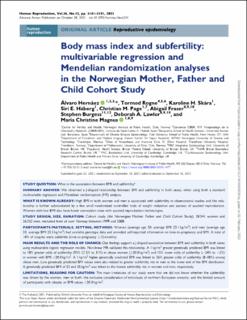| dc.contributor.author | Hernaez Camba, Alvaro | |
| dc.contributor.author | Rogne, Tormod | |
| dc.contributor.author | Skåra, Karoline Hansen | |
| dc.contributor.author | Håberg, Siri Eldevik | |
| dc.contributor.author | Page, Christian Magnus | |
| dc.contributor.author | Fraser, Abigail | |
| dc.contributor.author | Burgess, Stephen | |
| dc.contributor.author | Lawlor, Deborah A. | |
| dc.contributor.author | Magnus, Maria Christine | |
| dc.date.accessioned | 2022-02-03T09:21:38Z | |
| dc.date.available | 2022-02-03T09:21:38Z | |
| dc.date.created | 2021-12-02T14:19:30Z | |
| dc.date.issued | 2021 | |
| dc.identifier.citation | Human Reproduction. 2021, 36 (12), 3141-3151. | en_US |
| dc.identifier.issn | 0268-1161 | |
| dc.identifier.uri | https://hdl.handle.net/11250/2976786 | |
| dc.description.abstract | STUDY QUESTION
What is the association between BMI and subfertility?
SUMMARY ANSWER
We observed a J-shaped relationship between BMI and subfertility in both sexes, when using both a standard multivariable regression and Mendelian randomization (MR) analysis.
WHAT IS KNOWN ALREADY
High BMI in both women and men is associated with subfertility in observational studies and this relationship is further substantiated by a few small randomized controlled trials of weight reduction and success of assisted reproduction. Women with low BMI also have lower conception rates with assisted reproduction technologies.
STUDY DESIGN, SIZE, DURATION
Cohort study (the Norwegian Mother, Father and Child Cohort Study), 28 341 women and 26 252 men, recruited from all over Norway between 1999 and 2008.
PARTICIPANTS/MATERIALS, SETTING, METHODS
Women (average age 30, average BMI 23.1 kg/m2) and men (average age 33, average BMI 25.5 kg/m2) had available genotype data and provided self-reported information on time-to-pregnancy and BMI. A total of 10% of couples were subfertile (time-to-pregnancy ≥12 months).
MAIN RESULTS AND THE ROLE OF CHANCE
Our findings support a J-shaped association between BMI and subfertility in both sexes using multivariable logistic regression models. Non-linear MR validated this relationship. A 1 kg/m2 greater genetically predicted BMI was linked to 18% greater odds of subfertility (95% CI 5% to 31%) in obese women (≥30.0 kg/m2) and 15% lower odds of subfertility (−24% to −2%) in women with BMI <20.0 kg/m2. A 1 kg/m2 higher genetically predicted BMI was linked to 26% greater odds of subfertility (8–48%) among obese men. Low genetically predicted BMI values were also related to greater subfertility risk in men at the lower end of the BMI distribution. A genetically predicted BMI of 23 and 25 kg/m2 was linked to the lowest subfertility risk in women and men, respectively.
LIMITATIONS, REASONS FOR CAUTION
The main limitations of our study were that we did not know whether the subfertility was driven by the women, men or both; the exclusive consideration of individuals of northern European ancestry; and the limited amount of participants with obesity or BMI values <20.0 kg/m2.
WIDER IMPLICATIONS OF THE FINDINGS
Our results support a causal effect of obesity on subfertility in women and men. Our findings also expand the current evidence by indicating that individuals with BMI values <20 kg/m2 may have an increased risk of subfertility. These results suggest that BMI values between 20 and 25 kg/m2 are optimal for a minimal risk of subfertility.
STUDY FUNDING/COMPETING INTEREST(S)
The MoBa Cohort Study is supported by the Norwegian Ministry of Health and Care Services and the Norwegian Ministry of Education and Research. This project received funding from the European Research Council under the European Union’s Horizon 2020 research and innovation program (grant agreement No 947684). It was also partly supported by the Research Council of Norway through its Centres of Excellence funding scheme, project number 262700. Open Access funding was provided by the Folkehelseinstituttet/Norwegian Institute of Public Health. D.A.L. is a UK National Institute for Health Research Senior Investigator (NF-SI-0611-10196) and is supported by the US National Institutes of Health (R01 DK10324) and a European Research Council Advanced Grant (DevelopObese; 669545). The funders had no role in the collection, analysis and interpretation of data; in the writing of the report; or in the decision to submit the article for publication. D.A.L. receives (or has received in the last 10 years) research support from National and International government and charitable bodies, Roche Diagnostics and Medtronic for research unrelated to the current work. The rest of the authors declare that no competing interests exist.
TRIAL REGISTRATION NUMBER
N/A. | en_US |
| dc.language.iso | eng | en_US |
| dc.publisher | Oxford University Press | en_US |
| dc.rights | Navngivelse-Ikkekommersiell 4.0 Internasjonal | * |
| dc.rights.uri | http://creativecommons.org/licenses/by-nc/4.0/deed.no | * |
| dc.title | Body mass index and subfertility: multivariable regression and Mendelian randomization analyses in the Norwegian Mother, Father and Child Cohort Study | en_US |
| dc.type | Peer reviewed | en_US |
| dc.type | Journal article | en_US |
| dc.description.version | publishedVersion | en_US |
| dc.source.pagenumber | 3141-3151 | en_US |
| dc.source.volume | 36 | en_US |
| dc.source.journal | Human Reproduction | en_US |
| dc.source.issue | 12 | en_US |
| dc.identifier.doi | 10.1093/humrep/deab224 | |
| dc.identifier.cristin | 1963507 | |
| dc.relation.project | National Institutes of Health: R01 DK10324 | en_US |
| dc.relation.project | ERC-European Research Council: 669545 | en_US |
| dc.relation.project | Norges forskningsråd: 262700 | en_US |
| dc.relation.project | EU – Horisont Europa (EC/HEU): 947684 | en_US |
| cristin.ispublished | true | |
| cristin.fulltext | original | |
| cristin.qualitycode | 2 | |

